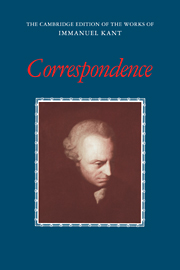Book contents
Introduction
Published online by Cambridge University Press: 07 September 2010
Summary
Kant's century cultivated letter-writing as an art form. In an age long before telephones, letters were often a necessity even for casual communication with friends and neighbors. But many supposedly private letters were clearly intended for the reading public, and many writers – scientists, philosophers, biographers, novelists – used the medium of letters to present their work. Lessing and Lichtenberg published “letters” on art, Euler and Lambert on physics, Reinhold and Schiller on philosophy and literature. Goethe, F. H. Jacobi, and Rousseau composed Briefromanen, novels in the form of letters, and one of Kant's first biographers, R. B. Jachmann, employed the format of “letters to a friend” to depict Kant's life and personality. Important literary feuds and exchanges such as the so-called pantheism controversy between Moses Mendelssohn and Friedrich Heinrich Jacobi were carried on, at least in part, in the style of personal correspondence.
One might therefore expect Kant too to have written his letters with an eye to posterity, composing them with polished elegance and precision. But that was not the case. Kant's private letters were indeed private. Most of them were written hastily, often after much procrastination, and usually in response to some specific question, obligation, or business – a recommendation for a student, a letter of introduction for some traveler, instructions to a publisher, sometimes simply a polite acknowledgment of someone else's letter a year earlier or an expression of thanks for a shipment of his favorite carrots and sausages.
Information
- Type
- Chapter
- Information
- Correspondence , pp. 1 - 42Publisher: Cambridge University PressPrint publication year: 1999
Accessibility standard: Unknown
Why this information is here
This section outlines the accessibility features of this content - including support for screen readers, full keyboard navigation and high-contrast display options. This may not be relevant for you.Accessibility Information
- 3
- Cited by
